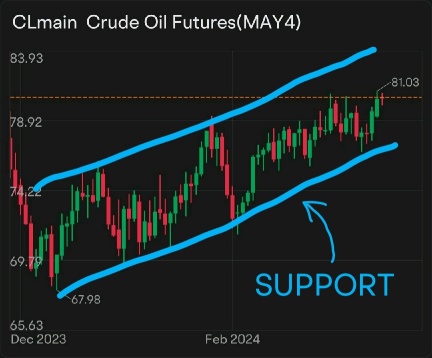No Data
No Data
WTI Tumbles to Near $74.00 as Trump Urges OPEC to Cut Oil Cost
Trump urges OPEC to lower oil prices, promising to actively promote interest rate cuts by the Federal Reserve.
① Trump demanded that OPEC countries such as Saudi Arabia lower oil costs at the Davos Forum, and called for immediate interest rate cuts to address economic chaos; ② He criticized the Biden administration for wasting $8 trillion on deficit spending, implementing destructive energy restrictions, severe regulations, and hidden taxes; ③ Trump praised SoftBank's commitment to invest in the U.S. and expressed hope that Saudi Arabia would increase its investment from $600 billion to $1 trillion.
WTI Extends Downside to Near $75.00 Amid Uncertainties
Oil's Downturn Temporary? Analyst Eyes Support At US$73
WTI Tumbles to Near $75.50 as Trump Plans to Boost Oil Output, Impose Tariffs
Oil Prices Decline Amid Tariff Threats And Trade Concerns












BelleWeather : I think proper portfolio positioning vis a vis inflation is important. The concern I have is stagflation, so I’m trying to be defensive to that. This is difficult. And timing the market is impossible and crazy-making, so I personally am taking each day as it comes.
I don’t think anyone is going to sell off over these concerns, and Powell is not about to fan those flames either!
SpyderCall OP BelleWeather : They might not sell over these concerns. But when these variables are present, then any negative catalyst will likely catalyze a selloff. For example, if we get bad rhetoric from Powell next week, then we might see extra volatility. That being said, in the current environment, any selloff will be a good buying opportunity until something breaks in the economy.
SpyderCall OP BelleWeather : So far, wages and employment numbers have held up, so stagflation is not a concern until inflation picks back up. With the way oil and gasoline prices have been climbing, we could possibly see a stagflationary environment soon, but not yet. Things are almost perfect in the economic data currently. We are in a goldilocks zone for the Fed right now. And if things get worse, then the Fed has already mentioned cutting rates. That would be even more accomodative for equities as the "Fed Put" will be in play at that point. So, if we do see stagflation, it shouldn't last long as the Fed will accommodate markets when the inflation, wages, or employment situation changes negatively.
BelleWeather : Agreed on the Goldilocks zone vis a vis the Fed mandate save one issue - the reserve bank balance is almost out - won’t they have to move to correct that?
SpyderCall OP BelleWeather : They have been greatly decreasing the balance sheet since march 2022. This is done through selling treasury bonds or mortgage securities. Short-term treasuries, like bills, have been the biggest culprits for the runoff of the balance sheet. This has been unwinding the massive amount of asset purchases since the 2008 financial crisis.
They purchased all of these assets back then as a form of quantative easing to boost the economy. Right now, they are selling treasury notes at sky-high yields to provide liquidity to banks essentially. This is putting more liabilities onto the balance sheet, which brings the balance down.
I don't think the balance sheet runoff is such a big deal at the moment.
Once the economy is showing signs of trouble, then I think we will need to worry about the Fed balance sheet. If they start buying assets, essentially quantative easing, then they might think that there is weakness in the economy.
You might think that with the Fed balance falling like it is, then long-term treasuries should be falling along with the balance. But that has not been the case since last November as these treasuries have been climbing.
This tells me that the balance sheet is now falling because the Fed is adding liquidity through short-term bond sales, which inject liquidity into the economy, which is good for an economy and equities.
View more comments...